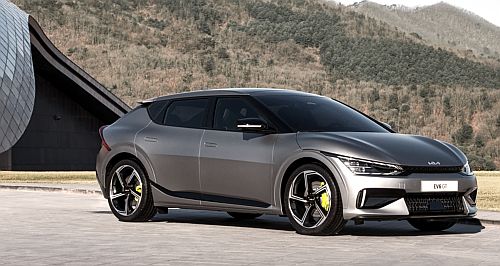Infrastructure more important than incentives, says Kia boss

ELECTRIC vehicle subsidies are simply “middle-class welfare” that doesn’t actually help the country get anywhere with regards to broader EV usability, according to Kia Australia CEO, Damien Meredith.
Mr Meredith has made statements like this before, but not as the CEO of the Australian arm of the company. Until just a few weeks ago, he was the chief operating officer, however he hasn’t changed his mind on the topic of electric vehicle subsidies.
In the same week that Victoria announced it would end its EV subsidies of $3000 at the end of June 2023 in a move to curb spending, Mr Meredith reiterated his opinion that any money being spent by state or federal governments should instead be funding the rollout of faster electric car chargers across the broad expanses of the Australian road network.
“I still believe that,” said Mr Meredith when asked whether he still feels the same way about incentives for buyers to upgrade what’s in their garage.
“I find it mind boggling that governments, mainly state governments can give $5000 or $6000, can give that sort of money, when, for me, that’s just middle-class welfare,” he said. “That’s just my opinion. I haven’t changed, and I won’t change on that.
“If you wanted to make an impact in regards to EVs and electrification, that type of money should have gone into infrastructure, and let market forces be market forces,” said Mr Meredith.
To a large degree, that’s what has happened up until recently, with changes in state governments only really sparking the notion of electric vehicle incentive programs as each different jurisdiction tries to enhance its green credentials.
But Mr Meredith stated that there are better ways to support the shift from internal combustion to electric transportation for the mass market consumer - and it comes down to making the technology more viable for the nation we live in, not just the states where people buy their car.
“That’s just my opinion. I’ve said that to governments. Every working party that’s been put together over the last three or four years, that’s been my opinion. I've been a lone voice, I might add. But that’s just my view.
“Governments should put the money into infrastructure. I’m reading a lot of stuff now, in the UK, where they’re saying that their infrastructure isn’t ready for the amount of vehicles that they’re selling )due to government EV incentives). Or there’s a fair bit of buyer remorse because of infrastructure issues in Western Europe.
“I can use personal experience - I’ve driven an EV down to Yarrawonga on the Murray River twice, and the first time I got held up at Goulburn, then I went to a slow charger at Yass that took over an hour to get to 80 per cent. And then the second time I went down, I couldn’t find one because it was on the top of a carpark but the map was telling me it’s there, but I couldn’t find it.
“From my point of view, the access to more points could have been a lot better done by governments and businesses,” he said.
There are some steps being taken that should assist in the improved access to charging networks across the nation. The federal government announced in April that it will partner with NRMA to provide 117 fast charging sites across the country, while state governments, councils and private companies are also expanding the charging corridors for different users to access fast-charging tech.
Tesla also recently announced it would open up its Supercharger network in select areas around Australia, following calls from brands such as Polestar to allow more egalitarian access to the fast-charging network.